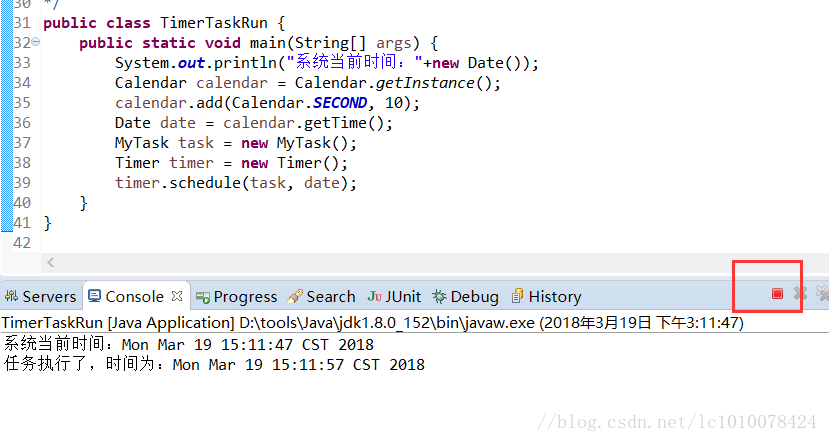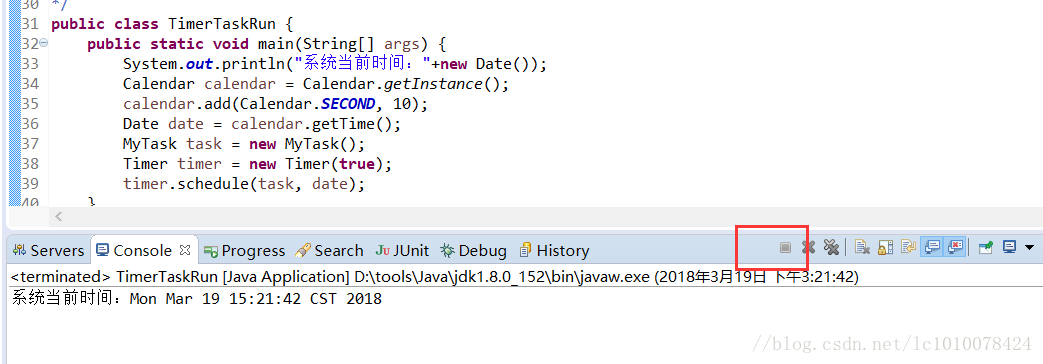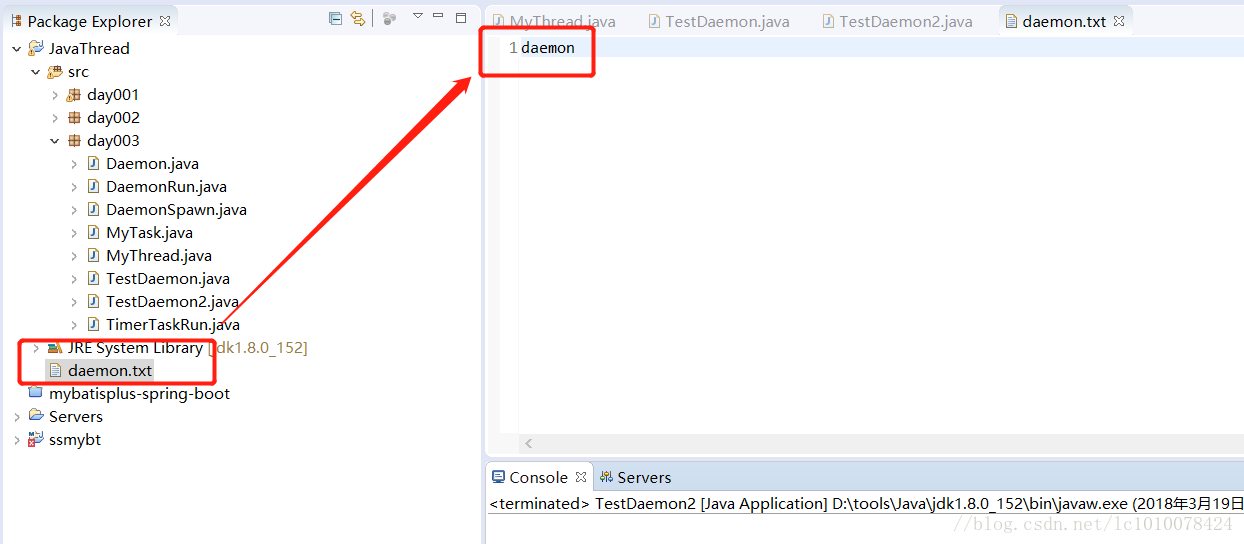Java中有两类线程:User Thread(用户线程)、Daemon Thread(守护线程)
用户线程即运行在前台的线程,而守护线程是运行在后台的线程。 守护线程作用是为其他前台线程的运行提供便利服务,而且仅在普通、非守护线程仍然运行时才需要,比如垃圾回收线程就是一个守护线程。当VM检测仅剩一个守护线程,而用户线程都已经退出运行时,VM就会退出,因为没有如果没有了被守护这,也就没有继续运行程序的必要了。如果有非守护线程仍然存活,VM就不会退出。
守护线程并非只有虚拟机内部提供,用户在编写程序时也可以自己设置守护线程。用户可以用Thread的setDaemon(true)方法设置当前线程为守护线程。
虽然守护线程可能非常有用,但必须小心确保其他所有非守护线程消亡时,不会由于它的终止而产生任何危害。因为你不可能知道在所有的用户线程退出运行前,守护线程是否已经完成了预期的服务任务。一旦所有的用户线程退出了,虚拟机也就退出运行了。 因此,不要在守护线程中执行业务逻辑操作(比如对数据的读写等)。、
另外有几点需要注意:
Timer代码示例:
package day003;
import java.util.Date;
import java.util.TimerTask;
/**
*
* 项目名称:JavaThread
* 类名称:MyTask
* 类描述:
* 创建人:liuc
* 创建时间:2018年3月19日 下午3:05:28
* 修改人:liuc
* 修改时间:2018年3月19日 下午3:05:28
* 修改备注:
* @version
*
*/
public class MyTask extends TimerTask{
/**
* (non-Javadoc)
* @see java.util.TimerTask#run()
*/
public void run() {
System.out.println("任务执行了,时间为:"+new Date());
}
}
-----------------------------------------------------------------------------------
package day003;
import java.util.Calendar;
import java.util.Date;
import java.util.Timer;
/**
*
* 项目名称:JavaThread
* 类名称:TimerTaskRun
* 类描述:
* 创建人:liuc
* 创建时间:2018年3月19日 下午3:08:01
* 修改人:liuc
* 修改时间:2018年3月19日 下午3:08:01
* 修改备注:
* @version
*
*/
public class TimerTaskRun {
public static void main(String[] args) {
System.out.println("系统当前时间:"+new Date());
Calendar calendar = Calendar.getInstance();
calendar.add(Calendar.SECOND, 10);
Date date = calendar.getTime();
MyTask task = new MyTask();
Timer timer = new Timer();
timer.schedule(task, date);
}
}
运行结果:
系统当前时间:Mon Mar 19 15:11:47 CST 2018
任务执行了,时间为:Mon Mar 19 15:11:57 CST 2018
任务虽然运行完了,但进程还未销毁,呈红色状态,为什么会出现这种情况呢?

可以看一下Timer的源码
/**
* Creates a new timer. The associated thread does <i>not</i>
* {@linkplain Thread#setDaemon run as a daemon}.
*/
public Timer() {
this("Timer-" + serialNumber());
}
/**
* Creates a new timer whose associated thread has the specified name.
* The associated thread does <i>not</i>
* {@linkplain Thread#setDaemon run as a daemon}.
*
* @param name the name of the associated thread
* @throws NullPointerException if {@code name} is null
* @since 1.5
*/
public Timer(String name) {
thread.setName(name);
thread.start();
}
可以看出每创建一个Timer就是启动一个新的线程,那么启动的线程不是守护线程,所以一直运行。那我们该如何将 新创建的的Timer改成守护线程呢?更改如上的代码:
package day003;
import java.util.Calendar;
import java.util.Date;
import java.util.Timer;
/**
*
* 项目名称:JavaThread
* 类名称:TimerTaskRun
* 类描述:
* 创建人:liuc
* 创建时间:2018年3月19日 下午3:08:01
* 修改人:liuc
* 修改时间:2018年3月19日 下午3:08:01
* 修改备注:
* @version
*
*/
public class TimerTaskRun {
public static void main(String[] args) {
System.out.println("系统当前时间:"+new Date());
Calendar calendar = Calendar.getInstance();
calendar.add(Calendar.SECOND, 10);
Date date = calendar.getTime();
MyTask task = new MyTask();
Timer timer = new Timer(true);
timer.schedule(task, date);
}
}
运行结果如下:
系统当前时间:Mon Mar 19 15:21:42 CST 2018

守护线程中产生的线程也是守护线程
如下示例:
package day003;
/**
*
* 项目名称:JavaThread
* 类名称:Daemon
* 类描述:
* 创建人:liuc
* 创建时间:2018年3月19日 下午3:30:53
* 修改人:liuc
* 修改时间:2018年3月19日 下午3:30:53
* 修改备注:
* @version
*
*/
public class Daemon implements Runnable {
private Thread[] t = new Thread[10];
/**
* (non-Javadoc)
* @see java.lang.Runnable#run()
*/
public void run() {
for (int i = 0; i < t.length; i++) {
t[i] = new Thread(new DaemonSpawn());
t[i].start();
System.out.println("DaemonSpawn " + i + " started.");
}
for (int i = 0; i < t.length; i++) {
System.out.println("t[" + i + "].isDaemon() = " + t[i].isDaemon() + ".");
}
while (true) {
Thread.yield();
}
}
}
-----------------------------------------------------------------------------------
package day003;
/**
*
* 项目名称:JavaThread
* 类名称:DaemonSpawn
* 类描述:
* 创建人:liuc
* 创建时间:2018年3月19日 下午3:32:06
* 修改人:liuc
* 修改时间:2018年3月19日 下午3:32:06
* 修改备注:
* @version
*
*/
public class DaemonSpawn implements Runnable {
/**
* (non-Javadoc)
* @see java.lang.Runnable#run()
*/
public void run() {
while (true) {
Thread.yield();
}
}
}
-----------------------------------------------------------------------------------
package day003;
import java.util.concurrent.TimeUnit;
/**
*
* 项目名称:JavaThread
* 类名称:DaemonRun
* 类描述:
* 创建人:liuc
* 创建时间:2018年3月19日 下午3:36:34
* 修改人:liuc
* 修改时间:2018年3月19日 下午3:36:34
* 修改备注:
* @version
*
*/
public class DaemonRun {
public static void main(String[] args) throws InterruptedException {
Thread d = new Thread(new Daemon());
d.setDaemon(true);//必须在启动线程前调用
d.start();
System.out.println("d.isDaemon() = " + d.isDaemon() + ".");
TimeUnit.SECONDS.sleep(1);
}
}
运行结果如图:
d.isDaemon() = true.
DaemonSpawn 0 started.
DaemonSpawn 1 started.
DaemonSpawn 2 started.
DaemonSpawn 3 started.
DaemonSpawn 4 started.
DaemonSpawn 5 started.
DaemonSpawn 6 started.
DaemonSpawn 7 started.
DaemonSpawn 8 started.
DaemonSpawn 9 started.
t[0].isDaemon() = true.
t[1].isDaemon() = true.
t[2].isDaemon() = true.
t[3].isDaemon() = true.
t[4].isDaemon() = true.
t[5].isDaemon() = true.
t[6].isDaemon() = true.
t[7].isDaemon() = true.
t[8].isDaemon() = true.
t[9].isDaemon() = true.
如果将mian函数中的TimeUnit.SECONDS.sleep(1);注释掉,看一下TimeUnit.SECONDS.sleep()的源码:
/**
* Performs a {@link Thread#sleep(long, int) Thread.sleep} using
* this time unit.
* This is a convenience method that converts time arguments into the
* form required by the {@code Thread.sleep} method.
*
* @param timeout the minimum time to sleep. If less than
* or equal to zero, do not sleep at all.
* @throws InterruptedException if interrupted while sleeping
*/
public void sleep(long timeout) throws InterruptedException {
if (timeout > 0) {
long ms = toMillis(timeout);
int ns = excessNanos(timeout, ms);
Thread.sleep(ms, ns);
}
}
其实就是对Thread.sleep()的封装,提供了可读性更好的线程暂停操作
注释后代码运行如下:
d.isDaemon() = true.
以上结果也说明了如果用户线程全部退出了,只剩下守护线程存在了,虚拟机也就退出了。
典型的守护线程是(GC)垃圾回收线程。
package day003;
/**
*
* 项目名称:JavaThread
* 类名称:MyThread
* 类描述:
* 创建人:liuc
* 创建时间:2018年3月19日 下午3:50:12
* 修改人:liuc
* 修改时间:2018年3月19日 下午3:50:12
* 修改备注:
* @version
*
*/
public class MyThread extends Thread{
private int i = 0;
/**
* (non-Javadoc)
* @see java.lang.Thread#run()
*/
public void run() {
super.run();
try {
while (true) {
i++;
System.out.println("i="+i);
Thread.sleep(1000);
}
} catch (Exception e) {
e.printStackTrace();
}
}
public static void main(String[] args) throws InterruptedException {
MyThread daemonThread = new MyThread();
daemonThread.setDaemon(true);
daemonThread.start();
Thread.sleep(5000);
System.out.println("当main线程执行完毕,守护线程也停止了。");
}
}
运行结果:
i=1
i=2
i=3
i=4
i=5
当main线程执行完毕,守护线程也停止了。
除 JVM 内部的守护线程外,用户可以通过以下方法设置守护线程:
public final void setDaemon(boolean on)可以通过以下方法查询线程是否为守护线程:
public final boolean isDaemon()关于守护线程的几个要点:
1、setDaemon 方法必须在 thread.start() 之前设置,否则会抛出 java.lang.IllegalThreadStateException 异常,不能将正在运行的常规线程设置为守护线程
package day003;
/**
*
* 项目名称:JavaThread
* 类名称:TestDaemon
* 类描述:
* 创建人:liuc
* 创建时间:2018年3月19日 下午4:01:32
* 修改人:liuc
* 修改时间:2018年3月19日 下午4:01:32
* 修改备注:
* @version
*
*/
public class TestDaemon {
public static void main(String[] args) {
Thread thread = new Thread();
thread.start();
thread.setDaemon(true);
}
}
运行结果:
Exception in thread "main" java.lang.IllegalThreadStateException
at java.lang.Thread.setDaemon(Thread.java:1359)
at day003.TestDaemon.main(TestDaemon.java:32)
2、不是所有的应用都可以分配给 Daemon 线程来进行服务,比如读写操作或者计算逻辑,因为在 Daemon 线程还没来的及进行操作时虚拟机可能已经退出了
package day003;
import java.io.File;
import java.io.FileOutputStream;
import java.io.IOException;
/**
*
* 项目名称:JavaThread
* 类名称:TestDaemon2
* 类描述:
* 创建人:liuc
* 创建时间:2018年3月19日 下午4:03:22
* 修改人:liuc
* 修改时间:2018年3月19日 下午4:03:22
* 修改备注:
* @version
*
*/
public class TestDaemon2 extends Thread{
/**
* (non-Javadoc)
* @see java.lang.Thread#run()
*/
public void run() {
super.run();
FileOutputStream outputStream = null;
try {
Thread.sleep(3000);
File file = new File("daemon.txt");
outputStream = new FileOutputStream(file);
outputStream.write("daemon".getBytes());
} catch (InterruptedException e) {
e.printStackTrace();
} catch (IOException e) {
e.printStackTrace();
} finally {
if (outputStream != null) {
try {
outputStream.close();
} catch (IOException e) {
e.printStackTrace();
}
}
}
}
public static void main(String[] args) {
Thread thread = new TestDaemon2();
thread.setDaemon(true);
thread.start();
}
以上代码中线程功能是向工程根目录的“daemon.txt”文件写入字符串“daemon”,实际运行结果发现并未成功写入,且未报任何错误,原因是写入文件的线程被设置为守护线程,该线程还在 sleep 过程中时所有用户线程就全部结束了,守护线程也会随着 JVM 一起退出。
如果将上面代码中的thread.setDaemon(true);注释掉,
public static void main(String[] args) {
Thread thread = new TestDaemon2();
//thread.setDaemon(true);
thread.start();
}
不将线程设置为守护线程可以在工程根目录的“daemon.txt”文件中看到字符串“daemon”

示例2:
package day003;
/**
*
* 项目名称:JavaThread
* 类名称:CustomThread
* 类描述:
* 创建人:liuc
* 创建时间:2018年3月19日 下午4:16:42
* 修改人:liuc
* 修改时间:2018年3月19日 下午4:16:42
* 修改备注:
* @version
*
*/
public class CustomThread extends Thread {
/**
* (non-Javadoc)
* @see java.lang.Thread#run()
*/
public void run() {
super.run();
for (int i = 0; i < 100; i++) {
System.out.println("Daemon Thread : " + i);
}
}
public static void main(String[] args) {
Thread daemonThread = new CustomThread();
daemonThread.setDaemon(true);
Thread userThread = new Thread();
daemonThread.start();
userThread.start();
}
}
多次执行示例2代码,控制台要么不打印任何信息,要么打印一部分循环的输出信息就结束了,从运行结果可以看出,守护线程并未执行完成所有循环就结束了,因为用户线程在守护线程执行循环的过程中就已全部结束,守护线程也随着 JVM 一起结束。
以上所述是小编给大家介绍的java守护线程与非守护线程详解整合,希望对大家有所帮助,如果大家有任何疑问请给我留言,小编会及时回复大家的。在此也非常感谢大家对亿速云网站的支持!
亿速云「云服务器」,即开即用、新一代英特尔至强铂金CPU、三副本存储NVMe SSD云盘,价格低至29元/月。点击查看>>
免责声明:本站发布的内容(图片、视频和文字)以原创、转载和分享为主,文章观点不代表本网站立场,如果涉及侵权请联系站长邮箱:is@yisu.com进行举报,并提供相关证据,一经查实,将立刻删除涉嫌侵权内容。